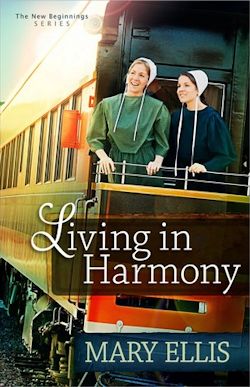
Mary Ellis grew up close to the Amish, where she loved their peaceful agrarian lifestyle and strong sense of Christian community. She and her husband now live by the largest population of Old Order in the country, where they take weekend trips to research her books. Mary enjoys reading, traveling, gardening, bicycling, and swimming. Before “retiring” to write full time, Mary taught middle school and worked as a sales rep for Hershey’s Chocolate—a job with amazingly sweet fringe benefits. Her debut Amish fiction, A Widow’s Hope, first in the Miller Family series, was a finalist in the 2010 ACFW Carol Awards and received the Award of Merit for the Holt Medallion. She has since written eight best-selling novels. . Find me at www.maryellis.net, www.maryeellis.wordpress.com, http://www.maryeellis.wordpress.com https://www.facebook.com/#!/pages/Mary-Ellis/126995058236. |
|
Genre HappeningsTime for New Beginnings by Mary
Ellis
|
|
|
What are readers of Amish fiction looking for? They want uplifting stories they can wrap themselves in to separate briefly from their normal lives. They want cultural accuracy, respect for the sect, positive endings, and spiritual growth among the characters. Amish fiction allows readers to step outside their own worlds and into a life that’s simpler and slower paced. Although most Amish books involve horses, buggies, and bonnets, and often include courting, rumschpringe, and differences between sects, readers expect writers to have their own “voice.” If you’d like to try your hand at writing this particular genre, you must do your research and find the story you’re destined to tell, then tell it in a way that’s uniquely yours. A couple years ago, I was given a nonfiction book by an editor at Harvest House: After the Fire: The Destruction of the Lancaster County Amish by Randy-Michael Testa. The book details the flight of Old Order Amish from Lancaster County, Pennsylvania, in particular, but also applies to Holmes and Wayne counties, Ohio—the area where I live and stage my romances. Skyrocketing land prices, rising taxes, and the influx of city water, sidewalks, and strict zoning codes have forced many families to look elsewhere to buy land. For over twenty years, young people who want to stay in farming have gone north or west where the dream of owning their own farm is still possible. Although the fire in Mr. Testa’s dissertation is metaphorical, it sparked a storyline for me. My series follows three sisters as they seek love and fresh starts in districts very different from the one they left behind. In Living in Harmony, first in the series, we meet Amy King—young, engaged, and Amish. Amy faces life-altering challenges when she loses both of her parents in a house fire. Her fiancé, John Detweiler, persuades her to leave Lancaster County and make a new beginning with him in Harmony, Maine, where he has relatives who can help them. John’s brother Thomas and sister-in-law, Sally, readily open their home to the newcomers. Wise beyond his years, Thomas, a minister in the district, refuses to marry Amy and John upon their arrival, suggesting instead a period of adjustment. While trying to assimilate in the ultraconservative district, Amy discovers an aunt who had been shunned. Amy wants to reconnect with her, but John worries the woman’s tarnished reputation will reflect badly on his beloved bride-to-be. Although I live within an hour of the largest population of Amish in the country, I learned a writer should visit the area where his or her novel will be set in, if it’s possible, because of the regional differences. Last summer I traveled to Waldo County, Maine, to research Living in Harmony. This Old Order district allows no rumschpringe, no courting buggies, no youth socials (everyone is present for all get-togethers), and no working in the English world; however, their church services are in English, not Deutsch, to encourage “drop-ins” from the local community. These Amish have an ecumenical outlook on Christianity, similar to New Order Amish, which makes up only 10 percent of the population. And they built a meetinghouse, instead of meeting in each other’s homes, to use for church, Sunday school (yes, they have it on “off” weeks), weddings, and fund-raising events. |
I discover interesting stories in every community I visit. Last fall I researched the Amish of Audrain, Randolph, and Boone counties, Missouri, in preparation to write book two of the series, Love Comes to Paradise. I found the Missouri Plain believers to be the most private and reserved of all I’ve met thus far. But one lovely wife and mother who ran an in-home bakery provided me with plenty of information and a few amusing tales. I just returned from Kentucky where I studied the Amish and Old Order Mennonite of Casey and Barren counties to prepare for book three of the series, A Little Bit of Charm. I traipsed up and down back roads in search of horses and buggies and those who prefer a slower pace of life. I stayed at the home of my best friend in Somerset and took along her three granddaughters to keep me company. During the interviews, they received a priceless education that surpassed anything found in textbooks. And having them with me opened more doors and lowered many people’s defenses. Who could resist three adorable little girls? Just when I thought I had these fascinating people figured out, I found a district that “breaks” a different set of rules. But one thing remains the same no matter where I travel or whatever name they assign to their Plain lifestyle: They love the Lord God and His Son first and foremost. They strive to keep Him central in their lives. Everything else is just details. Isn’t that how it should be for all Christians? I’m often asked what practical lesson have I learned since writing about the Amish. One can’t study another’s culture and traditions without her own life being impacted. I learned to trust God in all matters. As a Christian, I have witnessed His awesome power to change lives. The Amish demonstrate their faith and trust each day. Although I might not be willing to give up health insurance, I’m ready to put God in charge of my life’s direction and stop swimming upstream. I hope you’ll look for Living in Harmony, first in the New Beginnings series from Harvest House.  |
|
|
|
|
|
|








